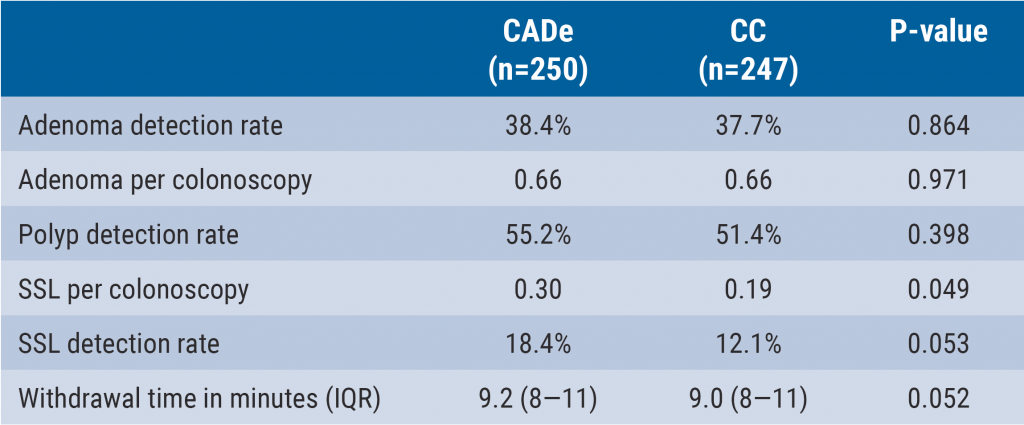https://doi.org/10.55788/90b4c58c
“Polyp detection rates are correlated with post-colonoscopy colorectal cancer rates,” outlined Dr Alexander Seager (Newcastle University, UK) [1]. “Therefore, any increase in detection may result in a direct patient benefit.” The current randomised-controlled trial compared the effectiveness of ‘GI Genius’-assisted colonoscopy (GGC) with standard colonoscopy (SC) in routine practice. For this purpose, 2,032 participants who were scheduled for colonoscopy were randomised 1:1 to GGC or SC. The study was executed across 10 hospitals in England. The primary endpoint was mean adenomas per procedure (MAP).
The MAP rates were 1.21 for participants in the SC group and 1.56 for participants in the GGC group (IRR 1.30; 95% CI 1.15–1.47; P<0.001). The key secondary outcome also favoured the GGC arm, with ADRs of 0.48 and 0.57 for the SC and GGC arms, respectively (OR 1.47; 1.21–1.78; P<0.001). “We also saw an SSP detection rate increase of 3.3% with GGC,” said Dr Seager. “If we bear in mind that a 1% increase in proximal SSP detection rate can decrease post-colonoscopy colorectal cancer rate by 7%, this is potentially a big finding.”
As expected, adjusted mean polyp sizes were smaller in the GGC arm, with 5.18 mm, compared with 5.78 mm in the SC arm (P=0.016). Interestingly, the study also showed that GGC was associated with an increased detection rate of polyps of a specific morphology, namely 0-IIa polyps (34% vs 27%; P=0.002). Finally, there were no significant differences with respect to withdrawal time or safety events.
In conclusion, GGC outperformed SC in terms of overall polyp detection rate, as well as ADR and SSP detection rate, without increasing adverse events. The increased detection rate for SSPs, in particular, may strongly reduce post-colonoscopy colorectal cancer rates.
- Seager A, et al. Colo-detect: a randomised controlled trial of polyp detection comparing colonoscopy assisted by the GI genius artificial intelligence endoscopy module with standard colonoscopy. LB18, UEG Week 2023, 14–17 October, Copenhagen, Denmark.
Copyright ©2023 Medicom Medical Publishers
Posted on
Previous Article
« Should we use E-SEMS or EVT for traumatic oesophageal perforations? Next Article
Can computer technology improve our everyday colonoscopy results? »
« Should we use E-SEMS or EVT for traumatic oesophageal perforations? Next Article
Can computer technology improve our everyday colonoscopy results? »
Table of Contents: UEGW 2023
Featured articles
SEQUENCE: Risankizumab doubles endoscopic remission rates compared with ustekinumab in CD
What’s New in Artificial Intelligence
Digital intervention relieves symptoms and improves QoL in IBS
GastroGPT: Successful proof-of-concept study of gastroenterology-specific large language model
Other Therapeutics and Outcomes
Primary results from MAESTRO-NASH trial: resmetirom efficacious for NASH
Apraglutide: Advancing the treatment of short bowel syndrome
Endobiliary radiofrequency ablation in pCCA: a pilot study
Raising awareness for microscopic colitis: disease course and predictors
Outcomes of IBD Trials
DIVERSITY1: Filgotinib results in Crohn’s disease leave investigators puzzled
SEQUENCE: Risankizumab doubles endoscopic remission rates compared with ustekinumab in CD
Guselkumab provides benefits in UC regardless of advanced therapy history
INSPIRE: Risankizumab meets all efficacy endpoints in UC
Risankizumab resolves extraintestinal manifestations in CD
Obefazimod takes the spotlight as promising UC treatment
Rapid response to upadacitinib boosts outcomes in severe Crohn’s disease
LUCENT trials: Mirikizumab works in UC, regardless of targeted therapy history
ARTEMIS-UC: New kid in town for UC
Breakthroughs in Colorectal Lesions
Safer removal of large polyps with cold snare technique
Higher recurrence rates with cold snare EMR than with conventional EMR
How to deal with at-risk patients above the CRC screening age limit?
European CRC screening needs to be revised
Advances in Upper Endoscopy and Colonoscopy
Epinephrine boosts efficiency in gastric ESD
Artificial intelligence-aided colonoscopy did not improve outcomes in Lynch syndrome
Can computer technology improve our everyday colonoscopy results?
Is AI-assisted colonoscopy ready for clinical practice?
Should we use E-SEMS or EVT for traumatic oesophageal perforations?
Related Articles
December 7, 2023
Epinephrine boosts efficiency in gastric ESD

December 7, 2023
Can computer technology improve our everyday colonoscopy results?
© 2024 Medicom Medical Publishers. All rights reserved. Terms and Conditions | Privacy Policy
HEAD OFFICE
Laarderhoogtweg 25
1101 EB Amsterdam
The Netherlands
T: +31 85 4012 560
E: publishers@medicom-publishers.com

